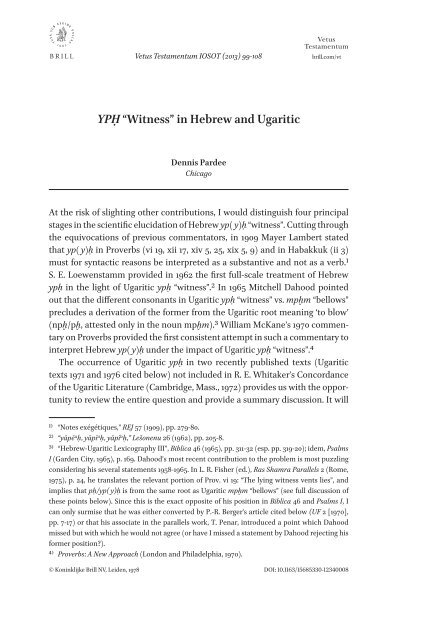Special Issue IOSOT 2013 - Books and Journals
Special Issue IOSOT 2013 - Books and Journals
Special Issue IOSOT 2013 - Books and Journals
Create successful ePaper yourself
Turn your PDF publications into a flip-book with our unique Google optimized e-Paper software.
Vetus Testamentum <strong>IOSOT</strong> (<strong>2013</strong>) 99-108<br />
Vetus<br />
Testamentum<br />
brill.com/vt<br />
YPḤ “Witness” in Hebrew <strong>and</strong> Ugaritic<br />
Dennis Pardee<br />
Chicago<br />
At the risk of slighting other contributions, I would distinguish four principal<br />
stages in the scientific elucidation of Hebrew yp( y)ḥ “witness”. Cutting through<br />
the equivocations of previous commentators, in 1909 Mayer Lambert stated<br />
that yp( y)ḥ in Proverbs (vi 19, xii 17, xiv 5, 25, xix 5, 9) <strong>and</strong> in Habakkuk (ii 3)<br />
must for syntactic reasons be interpreted as a substantive <strong>and</strong> not as a verb.1<br />
S. E. Loewenstamm provided in 1962 the first full-scale treatment of Hebrew<br />
ypḥ in the light of Ugaritic ypḥ “witness”.2 In 1965 Mitchell Dahood pointed<br />
out that the different consonants in Ugaritic ypḥ “witness” vs. mpḫm “bellows”<br />
precludes a derivation of the former from the Ugaritic root meaning ‘to blow’<br />
(npḫ/pḫ, attested only in the noun mpḫm).3 William McKane’s 1970 commentary<br />
on Proverbs provided the first consistent attempt in such a commentary to<br />
interpret Hebrew yp( y)ḥ under the impact of Ugaritic ypḥ “witness”.4<br />
The occurrence of Ugaritic ypḥ in two recently published texts (Ugaritic<br />
texts 1971 <strong>and</strong> 1976 cited below) not included in R. E. Whitaker’s Concordance<br />
of the Ugaritic Literature (Cambridge, Mass., 1972) provides us with the opportunity<br />
to review the entire question <strong>and</strong> provide a summary discussion. It will<br />
1) “Notes exégétiques,” REJ 57 (1909), pp. 279-80.<br />
2) “yāpē a ḥ, yāpī a ḥ, yāpî a ḥ,” Lešonenu 26 (1962), pp. 205-8.<br />
3) “Hebrew-Ugaritic Lexicography III”, Biblica 46 (1965), pp. 311-32 (esp. pp. 319-20); idem, Psalms<br />
I (Garden City, 1965), p. 169. Dahood’s most recent contribution to the problem is most puzzling<br />
considering his several statements 1958-1965. In L. R. Fisher (ed.), Ras Shamra Parallels 2 (Rome,<br />
1975), p. 24, he translates the relevant portion of Prov. vi 19: “The lying witness vents lies”, <strong>and</strong><br />
implies that pḥ/yp( y)ḥ is from the same root as Ugaritic mpḫm “bellows” (see full discussion of<br />
these points below). Since this is the exact opposite of his position in Biblica 46 <strong>and</strong> Psalms I, I<br />
can only surmise that he was either converted by P.-R. Berger’s article cited below (UF 2 [1970],<br />
pp. 7-17) or that his associate in the parallels work, T. Penar, introduced a point which Dahood<br />
missed but with which he would not agree (or have I missed a statement by Dahood rejecting his<br />
former position?).<br />
4) Proverbs: A New Approach (London <strong>and</strong> Philadelphia, 1970).<br />
© Koninklijke Brill NV, Leiden, 1978 DOI: 10.1163/15685330-12340008








![Am HaSefer [Volk des Buches] - Books and Journals](https://img.yumpu.com/20648352/1/174x260/am-hasefer-volk-des-buches-books-and-journals.jpg?quality=85)







